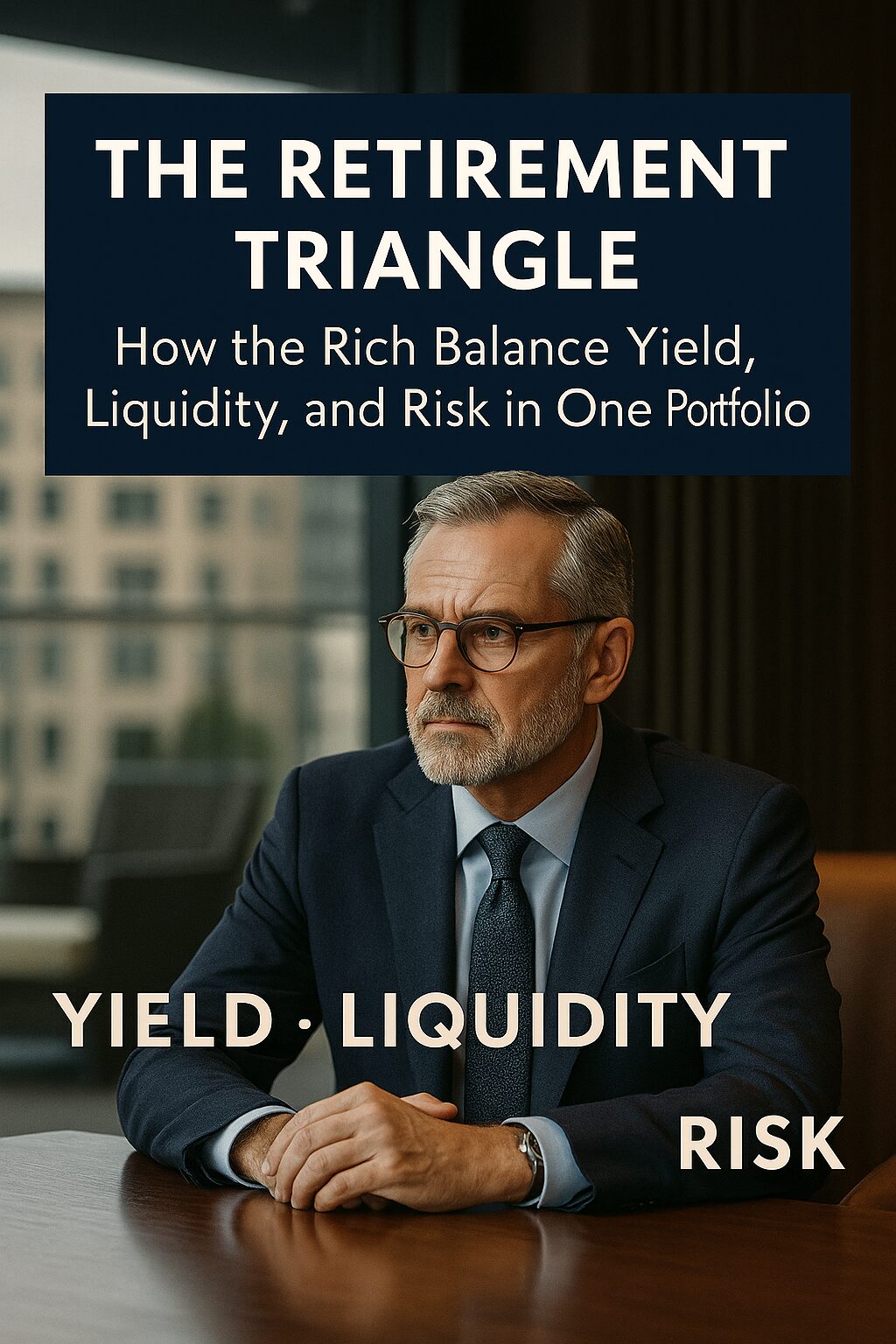The Retirement Triangle Mindset
Wealthy individuals approach retirement planning very differently from the average saver. While most people focus solely on building a nest egg, the rich prioritize balance between three critical factors: Yield (income generation), Liquidity (access to funds), and Risk (capital preservation). This framework, often referred to as the Retirement Triangle, ensures that their portfolios can weather market volatility, provide steady income, and remain flexible enough to seize opportunities.
Unlike traditional models that prioritize only growth or income, the Retirement Triangle acknowledges that financial security in retirement is a multi-dimensional challenge. The rich view money as a tool for control, not just consumption. That means ensuring their assets can serve them in any market condition — whether inflation spikes, interest rates rise, or the global economy slows.
2. Yield – Generating Predictable Income
For the wealthy, yield is not about chasing the highest percentage; it’s about ensuring consistent, predictable cash flow. High-net-worth retirees often build diversified income streams to reduce dependency on any single source.
Key yield strategies:
- Dividend Growth Stocks: Companies like Johnson & Johnson, Procter & Gamble, and Coca-Cola are popular because they have long histories of increasing dividends, often above inflation rates.
- Global Bonds: While U.S. Treasuries are a safe haven, wealthy investors diversify into sovereign bonds from countries like Canada, Australia, and the UK to reduce currency risk.
- Income-Generating Real Estate: Commercial properties, REITs, and rental apartments in high-demand cities provide both income and inflation protection.
- Private Credit Funds: Lending capital to businesses or real estate developers at negotiated interest rates, offering higher yields than traditional bonds.
The focus here is reliability, not speculation. Yield assets are chosen for their ability to maintain payouts even during recessions.
3. Liquidity – Ensuring Access to Capital
Liquidity is the often-overlooked pillar of retirement planning. While yield assets provide income, they can be illiquid during emergencies. The rich make sure that at least 20–30% of their portfolio is in highly liquid form.
Common liquidity strategies:
- Cash & Money Market Funds: These offer instant access for emergencies or opportunities.
- Short-Term Bonds & T-Bills: U.S. Treasury Bills maturing in 3–12 months allow quick conversion to cash.
- Foreign Currency Holdings: Wealthy investors in the U.S. often hold Canadian dollars, euros, or Swiss francs as part of their liquidity reserve, reducing dependence on one currency.
- Line of Credit Against Assets: Ultra-wealthy individuals sometimes use a securities-backed line of credit, enabling them to access cash without selling investments (and triggering taxes).
Liquidity protects against being forced to sell valuable long-term assets during market downturns — a mistake many middle-class retirees make.
4. Risk Management – Protecting Capital
The third leg of the Retirement Triangle is risk control. High-net-worth retirees know that losing money hurts more than gaining the same amount helps. This means they invest heavily in risk mitigation.
Risk control strategies:
- Diversification Across Asset Classes: Equities, bonds, commodities, real estate, and private equity.
- Geographic Diversification: Holding assets in multiple countries reduces exposure to local economic or political shocks.
- Hedging With Options or Futures: Selling covered calls or buying protective puts to limit downside in volatile markets.
- Alternative Assets: Gold, fine art, and even farmland, which historically hold value during inflationary periods.
Risk management ensures that one bad year doesn’t derail decades of careful planning.
5. The Balanced Retirement Portfolio – Real Examples
Looking at the portfolios of wealthy retirees in the U.S., Canada, and the UK reveals consistent patterns.
Example: High-Net-Worth Retiree Portfolio (USD 10M net worth)
- 35% Yield Assets: Dividend stocks, REITs, corporate bonds
- 25% Liquidity Assets: Cash, T-bills, short-term bonds
- 40% Growth & Risk-Managed Assets: Global equities, alternatives, private equity
This approach generates a 3–4% annual yield, maintains liquidity for 2–3 years of living expenses, and grows capital to outpace inflation.
6. Step-by-Step Implementation
For those building their own Retirement Triangle:
- Calculate Your Annual Retirement Expenses – This determines your liquidity needs.
- Identify Reliable Yield Sources – Aim for assets that have maintained or grown payouts through past recessions.
- Set Risk Boundaries – Decide the maximum drawdown you can tolerate in a year.
- Rebalance Regularly – Adjust allocations annually to maintain triangle proportions.
7. Conclusion – Financial Freedom Through Balance
The Retirement Triangle isn’t just a strategy; it’s a philosophy of balance. By focusing on yield, liquidity, and risk in equal measure, wealthy retirees create portfolios that deliver income, flexibility, and resilience.
For anyone seeking true financial independence, this model offers a timeless roadmap — one that can be adapted to any market condition, currency, or economic cycle.
📌 Next Article Preview:
In our next article, we’ll explore “Global Tax Optimization – Legal Strategies to Minimize Your Worldwide Tax Burden.” You’ll learn how high-net-worth individuals use tax treaties, offshore structures, and residency planning to keep more of their earnings.
